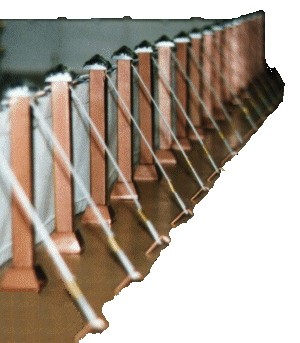![]() Curtains of the Outer Court
Curtains of the Outer Court

Curtains of the Outer Court . If you had suddenly come across the children of Israel in the desert
wilderness, you would have seen a spralling camp of over two million people,
probably not unlike the refugee camps in Rwanda, though perhaps more orderly.
The tents were probably black and brown, set in contrast with the sandy and
rocky colours of the desert.
In the center of their camp, you would see the white linen curtains of the
Tabernacle's Outer Court, approximately 46 metres long (c. 150 feet), 23 metres
wide (c. 75 feet) and 2.3 metres tall (c. 7.5 feet). It was so noticeable
against the surrounding rather drab colours of the camp and wilderness. It was
impossible to see inside the Tabernacle from the camp outside: the tall, white,
fine twined linen curtains made a separation between the outside world and the
beauty that was contained in the Tabernacle.
In the Bible, white linen signifies righteousness (Revelation 19:8). God in
His nature is right and just. He therefore expects us, His created people, to
act rightly and justly: this is what righteousness means. Psalm 92:15 tells us
the Lord is upright and there is no unrighteousness in Him. Psalm 45:7 predicts
that the Anointed One (the Messiah, the Christ) will love righteousness and hate
wickedness.
Because God is righteous, we find that the Levites, who God called
to be priests to serve Him in the Tabernacle, were instructed to wear fine white
linen garments (Exodus 28:39-43).
Likewise, in the New Testament, Revelation 19:6-9 speaks of the "wife of the
Lamb" (the bride of Christ), who is seen clothed in fine white linen. The "wife
of the Lamb" is a corporate bride, composed of all those people who have
accepted God's saving invitation to be joined to Him at this marriage feast and
have prepared themselves (as seen by their garments): they are all dressed in
fine white linen, as were the priests of the Tabernacle; Revelation 19:8 informs
us that the fine linen is their righteous acts.
By way of contrast, in Isaiah 64:6 we read that all our "righteousnesses" are
like filthy rags and that our sins have blown us right off course from God's
righteousness. Therefore, our sins have separated us from God (Isaiah 59:2).
Just as Adam's sin caused him to be separated from God and the garden of Eden
(Genesis 3:23-24), so we have all sinned and fall short of the glory of God
(Romans 3:23). Therefore, the white linen curtains of the Outer Court remind us
that we are separated from God, due to our sins, because He is righteous.
The fine white linen curtains of the Outer Court were
supported by pillars, at least 56 of them. The pillars were set in base sockets
of bronze and capped with silver capitals.
The bronze base sockets symbolise being made perfect through suffering and testing.
The capitals on top of the pillars were made from silver, symbolising the
ransom price God placed on each of the children of Israel (Exodus 30:11-16). God
desires to redeem people,
not to condemn them, but to satisfy His righteousness a price must be paid. When
Jesus was betrayed by Judas Iscariot, the price paid was thirty pieces of silver
(Matthew 26:15 & Zechariah 11:12-13). Exodus 12:1 to 13:16 shows the other
side of redemption: the way to redeem the life of the first-born son was by the
sacrifice of a lamb at Passover. God sacrificed His only Son, Jesus the Lamb of
God (John 1:29) at Calvary, as the final Passover Lamb (I Corinthians 5:7)
during the Feast of
Passover in 33 AD, in order to redeem mankind, that is to buy us back from
sin and all its effects (Romans 5:6,18).
When we see the white curtains of the Outer Court, we are reminded that our sins have separated us from God (Isaiah 59:2 and Romans 3:23). When we read the gospel accounts of the life of Jesus, we see His compassion and love to people and we also see His condemnation of hypocrisy and sin (John 8:10-11). We see in Jesus Christ a man who loves righteouness and hates lawlessness (Hebrews 1:9), the Son of God in whom God the Father delights (Matthew 17:5), the Son who is the bright shining of God's glory and the express image of God's righteous person (Hebrews 1:3). Just like the curtains of the Outer Court, the righteousness of Christ is supported by His judgement of sin and capped by His desire to redeem us, to bring us (the unrighteous ones) back to God (I Peter 3:18). The good news is that although we start off outside the Tabernacle, separated from God, there is a way into the Outer Court, a Door, colorful and welcoming, beckoning us to come inside.